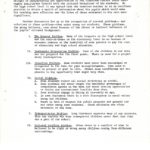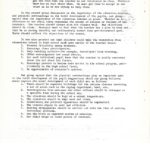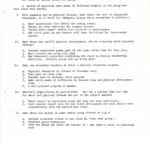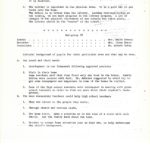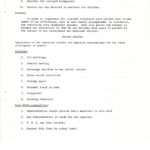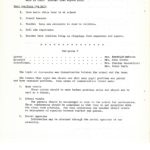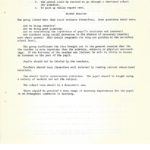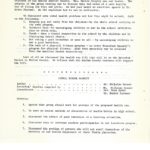Pine Mountain Settlement School
Series: EDUCATION
1963 GUIDANCE INSTITUTE REPORT (pp. 26-37)
TAGS: 1963 Guidance Institute Report (pp. 26-37) ; Harlan (KY) County Board of Education ; Harlan Independent Board of Education ; Lynch Independent Board of Education ; drop-out problems ; social problems ; transportation problems ; cultural conflicts ; narrow vision ; unfair classifications ; importance of teachers ; physical surroundings ; classroom television ; physical education ; health education ; teachers helping teachers ; Dayhoit, Pine Flat and Watts Creek Faculties ; Loyall School Faculty ; health tax ;
The 1963 Guidance Institute Report covers the 22nd annual meeting of youth leaders in Harlan County (KY). The meetings were sponsored by Harlan County Board of Education, Harlan Independent Board of Education and the Lynch Independent Board of Education.
The following are images and transcriptions of pages 26 through 37 of the 1963 GUIDANCE INSTITUTE REPORT.
See also:
1963 GUIDANCE INSTITUTE REPORT (pp. 1-25)
1963 GUIDANCE INSTITUTE REPORT (pp. 38-48)
1963 GUIDANCE INSTITUTE REPORT (pp. 49-58)
The PMSS Collections also contain material from several Youth Guidance Institutes held at the Pine Mountain Settlement School in the 1930s and 1940s. Images of those documents have been downloaded to this site and links to this material can be found here.
GALLERY – 1963 GUIDANCE INSTITUTE REPORT (pp. 26-37)
- 1963 Guidance Institute Report. “Our Youth: Needs and Resources,” p. 26.
- 1963 Guidance Institute Report. “Our Youth: Needs and Resources,” p. 27.
- 1963 Guidance Institute Report. “Our Youth: Needs and Resources,” p. 28.
- 1963 Guidance Institute Report. “Our Youth: Needs and Resources,” p. 30.
- 1963 Guidance Institute Report. “Our Youth: Needs and Resources,” p. 31.
- 1963 Guidance Institute Report. “Our Youth: Needs and Resources,” p. 32.
- 1963 Guidance Institute Report. “Our Youth: Needs and Resources,” p. 33.
- 1963 Guidance Institute Report. “Our Youth: Needs and Resources,” p. 34.
- 1963 Guidance Institute Report. “Our Youth: Needs and Resources,” p. 35.
- 1963 Guidance Institute Report. “Our Youth: Needs and Resources,” p. 36.
TRANSCRIPTION: 1963 Guidance Institute Report (pp. 26-37)
[Scan_0026.jpg] Carbon copy of typewritten document, page 26.
-26-
HALL AREA
Sub-group I
Leader . . . . . . . . . . . Mrs. Jane Wilson
Recorder . . . . . . . . . .Mr. Warren Napier
Consultant . . . . . . . . Dr. Paul Clark
After much discussion, Sub Group I came to the conclusion that many seemingly insurmountable obstacles facing the students of our area could become bridges of understanding and appreciation if the classroom teacher would thoroughly familiarize himself with the cultural background of his students. On the high school level it was agreed that the homeroom teacher is in an excellent position to obtain a wealth of information about his pupils which would make his teaching more effective and the lives of those entrusted to his care more significant.
Further discussion led us to the recognition of several problems — and solutions to these problems — that exist among our students. These problems, the group believes, come about because of the direct or indirect influence of the pupils’ cultural background:
I. The Drop-out Problem. Many of the dropouts on the high school level and the stay-at-homes on the elementary level do so because of economic reasons or the inability of some parents to pay the cost of elementary and high school education.
II. Inadequate Preparation Problem. Some of the children in our area are not prepared for the first grade. There is need for a preparatory kindergarten.
III. Incentive Problem. Some students have never been encouraged or recognized in the home for past accomplishments. Some seem to have no purpose or goal in life. Others seem indifferent and are passive to any opportunity that might help them.
IV. Social Problems.
A. Some students reject all social activities as sinful.
B. Some students are never taught the healthful advantages of competitive sports in the home and never develop appreciation or derive any recreational benefits from them.
C. Some students engage in dating at too early an age.
D. In some instances there is a wide discrepancy in moral values among our children.
E. There is lack of respect for public property and general law and order among some students. These attitudes are often traceable to the home.
V. Transportation Problem. Long distances separate many of our students. This may explain why some transported children never feel that they are a part of the school.
VI. Cultural Conflict Problem. Often there is a conflict of what is believed to be right or wrong among children coming from different surroundings.
[Scan_0027.jpg] Carbon copy of typewritten document, page 27.
-27-
VII. Problem of Narrow Vision. Often there is a mistaken idea among same students that the diploma is an end in itself rather than a means to a fuller life.
VIII. Unfair Classification Problem. Some teachers classify, unconsciously perhaps, students as intelligent, superior, average, dumb, or stupid. Many times only the more gifted are taught, while others are ignored. For this reason, many children — and rightly so — get the idea that the teacher is not interested in them. Children know how we feel about them. We must get them to accept us and trust us as we are trying to help them.
In the second group discussion on the importance of the classroom, teacher, and physical surroundings on the total development of the pupils, our group agreed that the importance of the classroom teacher is great. Whether he is effective or not shall often determine the extent of success or failure of his students. The teacher should always plan his classes well. His objectives should be clear. students need to feel that the teacher has a plan in mind and in that he is moving smoothly and deliberately toward some pre-determined goal. Tests should reflect the objectives of the course.
It was also pointed out that children could make the transition from elementary school to high school much more easily if the teacher would:
1. Promote friendship among students.
2. Encourage class participation.
3. Vary teaching methods — for example, investigate team teaching.
4. Offer encouragement and sound advice.
5. Let each individual pupil know that the teacher is really concerned about him and about his future.
6. Encourage parents to become more active in the school program, particularly on the high school level.
7. Be appreciative of everyone’s opinion.
Our group agreed that the physical surroundings play an important part in the total development of the pupil. Suggestions which our group believes would improve the total development of each child are as follows:
1. There should be separate buildings for the various classes involving a lot of noise such as the typing department, band, etc.
2. Interruptions from salesmen and other callers should be arranged at a specific time during the school day.
3. The classroom should be kept at a normal temperature.
4. The classroom should be kept neat and clean.
5. Cleanliness and personal appearance should be emphasized.
6. The teacher should be neat and efficient.
7. Seating arrangements should be carried out with the idea of solving individual problems.
8. Use the block or ungraded system of teaching.
9. Use field trips to local points of interest.
[Scan_0028.jpg] Carbon copy of typewritten document, page 28.
-28-
Sub-group II
Leader. . . . . . . . . . . Mr. Cecil Hensley
Recorder. . . . . . . . . .Miss Lynette Long
Consultant. . . . . . . . Dr. James Powell
Cultural Background of Students
The group members noted that the influence of the home had an important bearing on the student in school and study . For instance, the student who is deprived of good books in the home, as well as travel, starts school with a definite disadvantage. The teacher must accept the student on the level which she finds him.
In our culturally deprived area, students face great difficulty because they must unlearn incorrect processes as well as learn the correct ones.
It was decided that television makes a dent in the need for cultural activities if these television programs are well chosen. Another remedy might be remedial reading classes for older students.
Possible solutions are:
(1) Special courses set up to meet the needs of the students such as remedial reading
(2) Grouping of students and experimenting with reading improvement such as the S.R.A. Plan already used
(3) Begin teaching students about their own area before going on to broader areas.
(4) Use of classroom television
Dr. James Powell discussed briefly classroom television. He pointed out that the television only presents it. The classroom teacher must follow up with effective discussion. We were also informed that at least one channel for television in classrooms will be available within the next year in every part of Kentucky. It is believed that educational television can improve cultural development in this area.
Questions that rested with the group were:
(1) Can a student be taught to appreciate an unfamiliar culture permanently or will he regress to a habit formerly learned.
(2) What are the advantages and disadvantages in team teaching for bettering cultural environment?
Importance of the Classroom Teacher and Physical Surroundings for the Total Development of Pupils
Since the teacher must become the kind of teacher that makes the important difference in the classroom, what can be done in pre-service and in-service…
[Scan_0029.jpg] MISSING
[Scan_0030.jpg] Carbon copy of typewritten document, page 30.
-30-
Many worthwhile activities are now erased from our culture. We as teachers must first sell students on the idea; then enable the parents to see the wholesomeness of good recreation.
Second Session
Topic: Importance of the classroom teacher and the physical surroundings for the total development of the pupil.
Dr. James A. Cawood joined our group.
A series of questions were asked by different members of the group and many ideas were shared.
I. With emphasis now on physical fitness, what about the cost of playground equipment; is it worth it? (Example: swings which accommodate 8 children.)
A. Need supervision (for safety and taking turns)
B. Swings are more beneficial for primary grades.
C. “Round Robin Games” enable more children to participate.
D. The 6-3-3 plan (in the future) will have facilities for inter-mural sports.
II. What about the child’s physical development, are we stressing daily physical fitness?
A. Teacher supervised games part of the time; allow time for free play.
B. Many schools are using this plan
C. Use democratic procedure permitting the child to develop leadership abilities. Minority group will go along also.
III. What can secondary teachers do about a physical education program?
A. Physical education is offered to freshmen only,
B. Take part of class time
C. Teacher must be enthused about program
D. Make child aware of difference in leisure time and physical development time.
E. A well-planned program is needed.
IV. Shouldn’t high-schools be specialized? How can a teacher take out time for moral and physical fitness and get in the subject matter?
A. There should be supervised study and help for each individual.
B. Each teacher should work for the total development and each should work cooperatively with the specialized class.
V. What about two grades in same school being divided by I.Q.’s?
A. Teacher sometimes refers to one class as “that dumb group.”
B. Children group themselves.
C. Find one thing the child can succeed in — get them to excel in something else.
[Scan_0031.jpg] Carbon copy of typewritten document, page 31.
-31-
D. Today our schools — with only one grade in each room — the exceptional child is “smothered down.”
VI. Are other physical areas important? (Your own classroom)
A. Give more consideration to your own classroom. B. Let children take a part in caring for the room, and praise then when it is deserved.
C. The Library is important in the physical area. It is a good way to get books into the home.
The School is no better than its library. Looking retrospectively at our county, we see much progress in the library program. A lot of changes in the physical environment of our schools has taken place. The Library should be the “center” of the school.
* * * * * * * * * * * * * * * * * * * * * * * * * * *
Sub-group IV
Leader . . . . . . . . . . Mrs. Marie Swaney
Recorder . . . . . . . . .Mrs. Irene Emery
Consultant . . . . . . . Dr. Robert Dubey
Cultural background of pupils for their particular area and what may be done.
A. Our youth and their needs
1. Development in our framework following approved practice
2. Visit in their home
Some teachers said that they found only one book in the homes. Family Bibles were covered with dust. Mr. Ambrose suggested he would try to get some newspapers and magazines in some of the homes he visited.
3. Some of the High School teachers were interested in meeting with grade school teachers in order to find out more about their students’ background.
B. The ways elementary teachers could help high school teachers
1. They are closer to the people they serve.
2. Through church and various clubs.
3. Try home visit. make a schedule as to the time of a visit with each family. let the family know about the time.
4. Teacher to accept home situation just as they are, to help understand the child’s background.
[Scan_0032.jpg] Carbon copy of typewritten document, page 32.
-32-
5. Try not to alienate any family but seek to become a part of it.
6. Grade school teacher could send list of things to high school that each teacher needs to know.
7. Find out what child needs to know through vocational school.
8. Go over record with 8th grade teacher to find the ability of child.
9. Consider the cultural background.
10. Teacher use own material to motivate our children.
Summary:
In order to compensate for cultural difference each teacher must become aware of the differences; that is most easily accomplished by visitation, and consulting with elementary teacher. This will assist the teacher to prepare his instruction so that he can motivate each pupil to perform to the fullest of his educational and emotional ability.
Second Session
Importance of the classroom teacher and physical surroundings for the total development of pupils
Problems:
1. Old buildings
2. Central heating
3. Encourage children to eat better lunches
4. Extra social activities
5. Storage space
6. Personal touch to room
7. Playground
8. Drinking fountains
Some other suggestions:
1. Administration should provide basic materials to work with
2. Ask administration if needs are not supplied.
3. P. T. A. may help teachers
4. Request help from the school board
[Scan_0033.jpg] Carbon copy of typewritten document, page 33.
-33-
5. Make list of needs.
6. Ask help from local clubs.
7. Transportation to extra activities at night
8. Home, school, church and community should work together for children.
9. Teacher most important part in the school, children are influenced more by their teacher than anyone else.
Ways teachers can help
1. Have music while band is at school
2. French. Lessons
3. Teacher keep own selection to show to children, 4. Tell own experience
5. Teacher have children bring in clippings from magazines and papers.
* * * * * * * * * * * * * * * * * * * * * * * * * * *
Sub-group V
Leader . . . . . . . . . . . . . Mrs. Fredrick Ambrose
Recorder . . . . . . . . . . . .Mrs. Alma Conken
Consultants. . . . . . . . . .Mrs. Charles Westerfield, Mrs. Rubye Early
The topic of discussion was Communication between the school and the home.
The reason this topic was chosen was that many pupil problems are parent and home centered problems. Some means of communication listed were:
1. Home visits
These visits should be made before problems arise and should not be used as a threat.
2. School visits
The parents should be encouraged to come to the school for conferences. These conferences should be scheduled so that they do not interfere with the classroom schedule. For this conference the teacher should create an atmosphere of equality between teacher and parent.
3. Social Agencies
Information may be obtained through the social agencies of our community.
[Scan_0034.jpg] Carbon copy of typewritten document, page 34.
-34-
4. Students Folders
The Student’s folder is another source of information about the pupil.
5. Open House at School
The group felt this was the most successful way of communication. This could be done in three ways: a. Displaying of child’s work.
b. The parent could be invited to go through a shortened school day schedule.
c. To pick up child’s report card.
Second Session
The group listed ways they could evaluate themselves. Some questions asked were:
Are we being creative?
Are we doing good planning?
Are we considering the importance of pupil’s attitudes and interest?
Are teachers using social promotion in the absence of necessary remedial work where needed? This merely compounds the drop out problem at the secondary school level.
The group reaffirmed the idea brought out in the general session that the teacher is more important than the schedule, subjects or physical surroundings. If the horizons of the teacher are limited, he will do little to arouse an interest on the part of the pupil.
Pupils should not be labeled by the teachers.
Teachers should keep themselves well informed by reading current educational materials.
One should invite constructive criticism. The pupil should be taught using a variety of methods and not the subject.
The school room should be a democratic one.
There should be provided a wide range of learning experiences for the pupil in an atmosphere conducive to learning.
[Scan_0035.jpg] Carbon copy of typewritten document, page 35.
-35-
DAYHOIT, PINE FLAT AND WATTS CREEK FACULTIES
Leader . . . . . . . . . . . .Mrs. Mattie Gregory
Recorder . . . . . . . . . . Mrs. Thelma Lay
Consultant . . . . . . . . .Mrs. Ann Shelley
The teachers from Dayhoit, Pine Flat, and Watts Creek met together in the basement of the Harlan Baptist Church. Mrs. Mattie Gregory was our leader. The purpose of the group meeting was to discuss ways and means of a core healthy way of living for boys and girls. We had just heard an excellent speech by Dr. Doane Fischer, he had explained how to use an audiometer.
We discussed some vital health problems and how they might be solved. Such as the following:
1. Keeping pop and candy from the children — by the whole school carrying on the same program.
2. Balanced diet — by encouraging children to eat in the school cafeteria, Also to drink milk.
3. Teeth – Have a dental inspection in the school by the children and by displaying dental charts.
4. Not eating a good breakfast or none at all — by encouraging children to eat a good breakfast.
5. The lack of a physical fitness program — to order President Kennedy’s program for physical fitness. Also free materials may be obtained from the American Dental Association,
Last of all we discussed the health tax bill that will be on the ballot in Harlan County. We believe that all Harlan County teachers will support the bill.
* * * * * * * * * * * * * * * * * * * * * * * * * * *
LOYALL SCHOOL FACULTY
Leader . . . . . . . . . . . . . . . . . . . . . . . . . Mr. Nicholas Brewer
Recorders’ Reports compiled by . . . Mr. Nicholas Brewer, Mrs. Nema Hyder, Dr. Emmit Burkeen
Minutes:
1. Agreed that group should work for passage of the proposed health tax.
2. To work on better methods of observation of health habits in high school.
3. Discussed the effect of good nutrition in a learning situation.
4. Discussed ways to increase student participation in our lunchroom program.
5. Discussed the problem of parents who will not avail themselves of the services of our health department or their family physician.
[Scan_0036.jpg] Carbon copy of typewritten document, page 36.
-36-
6. Better health record keeping is imperative. There must be better use made of these records or the time spent preparing these records is wasted.
7. The continuous Health Supervision Program may be the answer to the problem we have because of the lack of physical examinations as prescribed by law. There is only one doctor in Loyall.
* * * * * * * * * * * * * * * * * * * * * * * * * * *
LOYALL AREA
Sub-group I
Leader. . . . . . . . . . . . . . . .Miss Mildred Mahoney
Recorder . . . . . . . . . . . . . .Mrs. Vera Brock
Consultant . . . . . . . . . . . . .Mrs. Nema Hyder
This area has been classed as culturally deprived; however, it is that the culture is different from that of other places.
The teacher should have a basic understanding of the culture in his particular area in order to accomplish more with the children.
The teacher should try to improve his own speech.
It was brought out that books used in the schools of this section portray a different culture from that of the pupils who use the books; therefore, the material in more difficult for them to understand, Perhaps letters to publishers might help this situation
Also it was suggested by our consultant, Mrs. Nema Hyder, that teachers write books containing reading matter and illustrations meaningful to the children.
There have been improvements in our culture. Music is a good example. (folk songs) Teachers have a great responsibility as far as music is concerned to teach an understanding of various types of music instead of just one. (hillbilly, for
example)
We should help build better background for literature and art. Also in social studies teach appreciation of other cultures.
* * * * * * * * * * * * * * * * * * * * * * * * * * *
Sub-group II
Leader . . . . . . . . . . . . . . Mrs. Willma Boggs
Recorder . . . . . . . . . . . . .Mrs. Augusta Smith
Consultant . . . . . . . . . . . Mr. James Ingle
After listening to the fine and inspiring addresses of Dr. Doane Fischer, Mr. P. F. Ayer and Dr. Jack Frymier, the Sub-group II of the the Loyall Geographical…
[Scan_0037.jpg] MISSING IMAGE
Go to: 1963 GUIDANCE INSTITUTE REPORT (pp. 38-48)
Return to: GUIDE TO YOUTH GUIDANCE INSTITUTES BY YEAR

